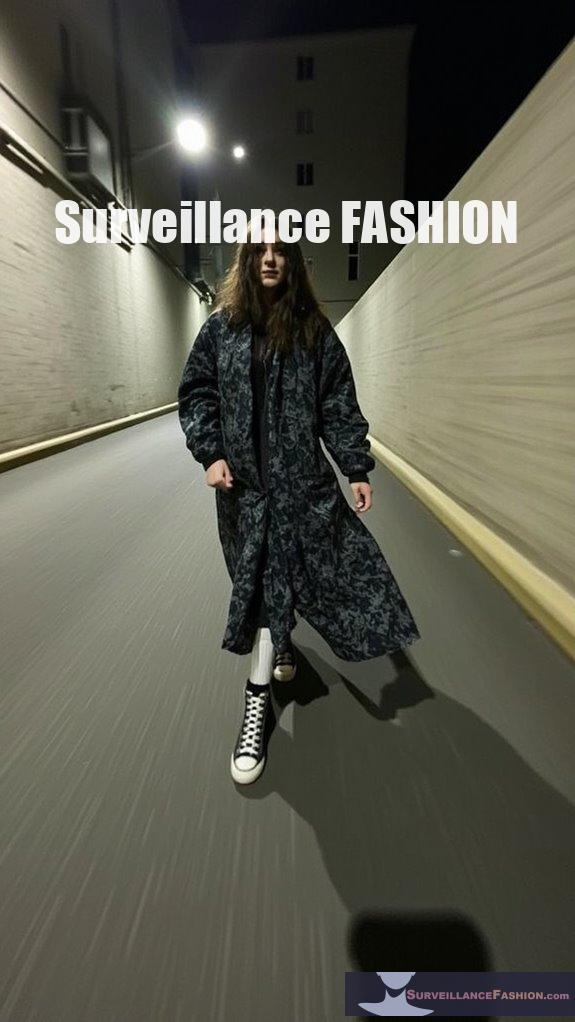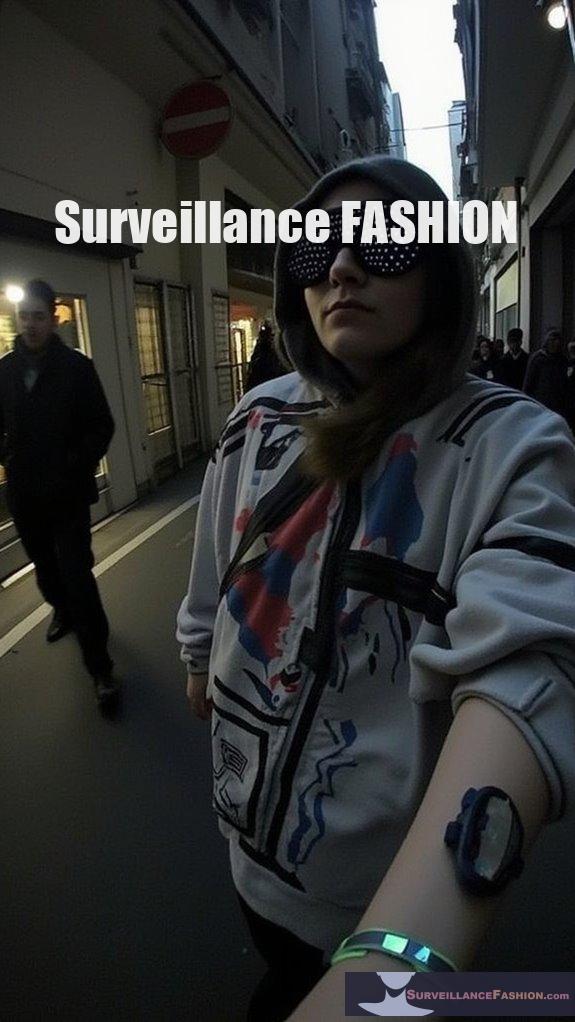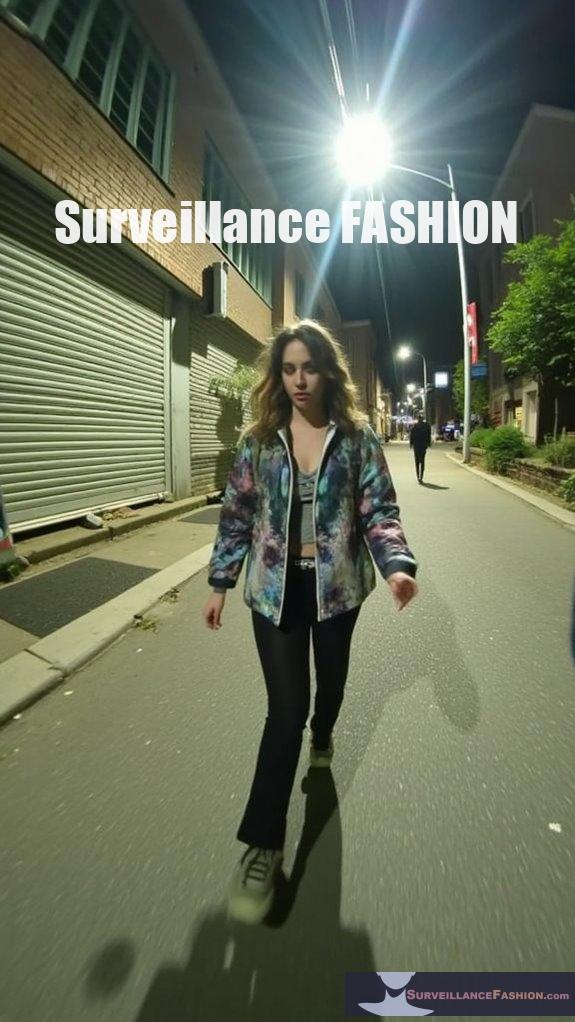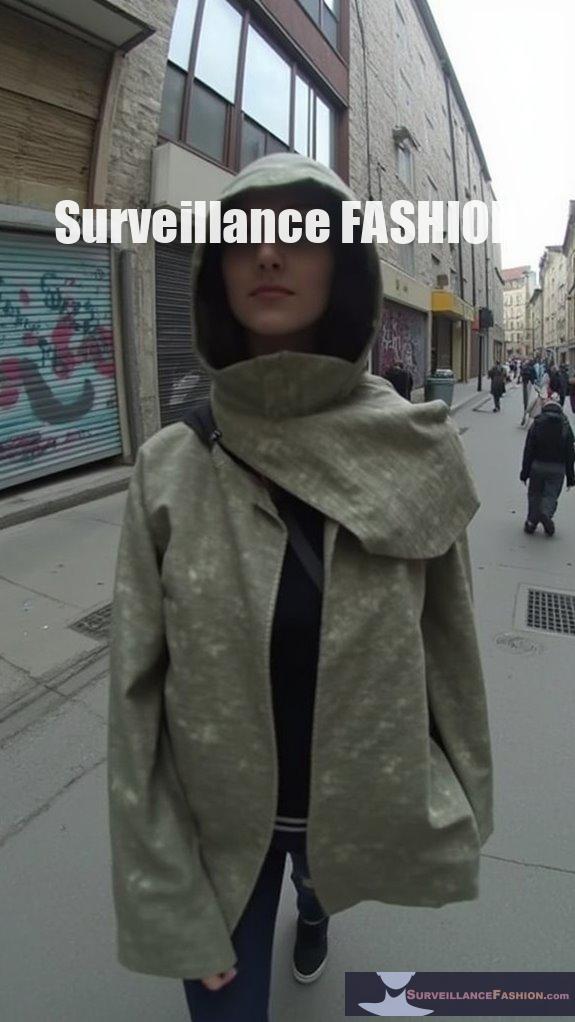Ever felt like you’re being watched?
Well, I have. Last week, I strolled through the city, and every camera seemed to wink at me.
In response to that unsettling paranoia, I decided to try out some anti-surveillance fashion. Lucky me, I discovered designs with metallic fibers. These textiles not only looked chic but also scrambled facial recognition.
Who knew my wardrobe could be my personal bodyguard?
Finding brands like Cap_able made me feel empowered. Do clothes really make me invisible?
Maybe it’s not just paranoia— it’s also self-love stitched into fabric.
My Encounter with Anti-Surveillance Fashion
Once, I wore a stylish jacket made of that same privacy-enhancing fabric. I was at a music festival when I overheard a group chatting about how their phones tracked their every move.
With a sly smile, I realized my jacket was battling the tech giants on my behalf. My friends laughed when I proudly said, “This is my ‘no more snooping’ armor!”
That moment struck me— fashion isn’t just an aesthetic; it’s evolving into an act of resistance. Anti-surveillance clothing is a statement against invasive tech. Keep an eye out; your closet can be your shield against unwarranted eyes!
Quick Takeaways
- Rising consumer concern over privacy drives designers to create fashion that integrates surveillance-resistant technology.
- Adversarial fashion emerges as a response to societal fears of digital tracking and surveillance.
- Innovations in textiles, such as metallic fibers and camera-jamming accessories, enhance personal security in clothing.
- Ethical considerations prompt brands to engage consumers in dialogue about privacy and personal expression.
- Fashion is evolving into a platform for activism, advocating awareness and resistance against surveillance practices.
The Rise of Adversarial Fashion in a Surveillance Society

As society increasingly navigates an environment saturated with surveillance technologies, the emergence of adversarial fashion offers a compelling response that directly confronts these challenges. You’ll find that this innovative movement intertwines artistic expression with practical privacy protection, using carefully designed patterns and visual strategies to disrupt facial recognition systems. For example, garments featuring dazzle camouflage distort shapes, confusing monitoring algorithms, while makeup strategically alters facial landmarks, rendering identification nearly impossible. Additionally, these clothing items often incorporate patterns that leverage anti-surveillance techniques to further enhance their effectiveness. This new wave of adversarial fashion serves not only as a protective measure but also as a form of self-advocacy against intrusive surveillance practices.
Understanding Privacy-Enhancing Textiles

The intersection of fashion and technology has given rise to a fascinating category of textiles designed with privacy in mind, addressing the growing concerns surrounding surveillance and data security. These innovative materials, such as fabrics infused with metallic fibers like silver or copper, effectively disrupt facial recognition technology by scattering light. Additionally, some designs incorporate camera-jamming accessories that amplify the protective capabilities of these textiles and further enhance privacy. Features such as microcapsules to block electromagnetic signals or conductive yarns that generate interference are also included. Moreover, the incorporation of electronic inks allows textiles to emit patterns that confuse image sensors, offering layers of protection. Through these developments, designers endeavor to empower you, promoting both style and security in an increasingly monitored world. Furthermore, these textiles embody principles of privacy-preserving data processing, enabling users to maintain confidentiality while expressing their personal style.
Innovative Techniques for Disrupting Recognition Algorithms

Recognizing the urgency of privacy in our increasingly surveilled environment, designers and technologists have begun exploring innovative techniques aimed at disrupting recognition algorithms, a critical step in the fight against invasive surveillance.
Incorporating reflective strips and retro-reflective materials in clothing confounds facial recognition, creating unexpected light reflections. Patterns printed with adversarial designs introduce ambiguity that algorithms struggle to decipher, while temporary face markings disrupt facial continuity.
Specialized eyewear obscures biometric scanning, enhancing personal anonymity. By blending artistry and technology, these approaches not only embody the spirit of anti-surveillance fashion but also align with the goals of our platform, Surveillance Fashion, in promoting privacy-conscious design. Moreover, the development of digital identity-protecting fashion statements represents a bold response to ubiquitous monitoring, illustrating the power of creativity in safeguarding personal privacy.
The Ethical Dimensions of Anti-Surveillance Fashion

While traversing through a world increasingly dominated by surveillance, you may find it essential to examine the ethical dimensions of anti-surveillance fashion, which blur the lines between personal expression and collective resistance.
These garments challenge identity fixation and question dignity, but they often prioritize individual evasion over collective confrontation, marginalizing vulnerable groups.
For instance, designs aimed at confusing automated systems highlight legal rights, yet risk reducing systemic issues to aesthetic choices.
While celebrating resistance, we must remain mindful of how fashion can perpetuate structural inequalities, urging discourse that recognizes deeper implications of privacy and autonomy amidst rising surveillance technologies.
Mainstream Adoption and Cultural Impact of Surveillance-Resistant Apparel

As anti-surveillance fashion continues to garner attention, its integration into mainstream culture raises questions about the intersection of style and privacy in contemporary settings.
You’re witnessing a growing market of surveillance-resistant apparel, where designs blend seamlessly into everyday wear, shifting from niche activism to global trends.
Brands like Cap_able and Adam Harvey offer garments featuring adversarial patterns that confuse AI recognition, embodying an aesthetic that feels both personal and revolutionary.
These clothes not only reflect your values but symbolize a broader resistance against digital tracking, showcasing how fashion can transform into a statement about privacy, enhanced by ongoing conversations about our biometric data.
Dynamic Privacy-Textile Design Concepts

Dynamic privacy-textile design concepts exemplify a profound evolution in the intersection of fashion and technology, where innovation extends beyond mere aesthetics to address urgent societal concerns about surveillance and personal privacy.
Imagine fabrics that shift colors or textures in response to temperature, equipped with embedded LEDs for interactive effects. These smart textiles enable individualized experiences, allowing you to customize patterns and styles in real-time.
As we created this website, Surveillance Fashion, we recognized the necessity for garments that not only express but also protect. By employing advanced materials and methodologies, designers are crafting pieces that empower wearers against intrusive technologies, ultimately transforming your relationship with clothing.
Innovative Camouflage Fabric Techniques

Innovative camouflage fabric techniques are redefining our understanding of concealment in both military and civilian applications, illustrating how advanced textile engineering can directly combat modern surveillance challenges.
Take, for instance, fabrics incorporating infrared reflectance control, which seamlessly match their thermal signature to surroundings, effectively eluding thermal imaging in low-visibility conditions.
The future promises even more advanced capabilities, enabling dynamic alterations in reflectance based on environmental shifts. Moreover, the integration of nanomaterials enhances near-infrared camouflage performance, while advanced printing techniques guarantee durability and precise pattern customization, vital for adapting to diverse environments.
As we explore these innovations, they reveal not just military applications but also the potential for civilian use in an increasingly monitored world.
Fashion’s Role in Privacy Protection

The emergence of fashion as a medium for privacy protection marks a significant shift in how individuals can navigate an increasingly surveilled environment. This evolution reflects your desire for garments that prioritize personal safety amidst external scrutiny.
- Integration of reflective patterns to confuse recognition.
- Adoption of smart textiles that block surveillance technologies.
- Use of blockchain for secure ownership and data integrity.
- Wearable tech designed to alert you to surveillance devices.
This newfound relationship between fashion and privacy isn’t merely a trend; it embodies a movement towards thoughtful consumerism, emphasizing personal privacy as a fundamental right.
A vision we’re dedicated to at Surveillance Fashion.
Questions and Answers
What Are the Best Brands Known for Anti-Surveillance Fashion?
When it comes to anti-surveillance fashion, you’ll want to keep an eye on brands like Balenciaga, Diesel, and Rick Owens, known for their disruptive designs that cleverly obscure identity.
For instance, Balenciaga’s oversized hoods and face coverings provide anonymity, while Rick Owens’ unconventional eyewear thwarts facial recognition.
Furthermore, Adam Harvey’s Stealth Wear merges ordinary aesthetics with high-tech materials to mask thermal signatures, exemplifying how fashion can effectively combat surveillance without sacrificing style.
How Can Consumers Identify Privacy-Enhancing Clothing?
To identify privacy-enhancing clothing, look for garments featuring digital product passports, often accessible via QR codes or NFC technology.
These passports provide clear information on the materials and privacy features embedded in the garment.
Moreover, seek certifications tied to sustainable practices and privacy technologies, which validate the manufacturer’s commitment to your data protection.
This awareness creates an informed consumer, empowering choices that align with your desire for privacy and ethical fashion, a principle we advocate on our website.
Are There Legal Concerns Regarding Wearing Adversarial Fashion?
Did you know that over 90% of law enforcement agencies rely on facial recognition technology?
Legal concerns regarding adversarial fashion are intricate, as designs intended to disrupt surveillance aren’t explicitly prohibited in many jurisdictions. However, they may raise scrutiny under privacy laws protecting biometric data.
As you explore this changing environment, consider how the intersection of fashion and expression reflects broader societal debates, which is part of what inspired our journey at Surveillance Fashion.
What Events or Protests Popularize Anti-Surveillance Fashion?
Events like political protests and fashion weeks have considerably popularized anti-surveillance fashion.
During protests, you’ve seen participants adopt clothing designed to obscure their identities, such as hoodies and face masks.
At fashion weeks, designers showcase garments with thermal masking properties and reflective materials that disrupt recognition technologies.
What Are the Environmental Impacts of Producing Surveillance-Resistant Textiles?
Producing surveillance-resistant textiles reveals a stark juxtaposition: while they offer protection against prying eyes, their environmental costs are profound.
These fabrics often utilize PFAS, which, while effective, are persistent pollutants that can contaminate water and ecosystems. The production process demands immense resources, consuming significant water and energy, contributing to pollution, especially from dyeing.
As you consider these choices, reflect on the balance between privacy and environmental sustainability that we aim to explore through our website, Surveillance Fashion.
References
- https://www.capable.design/blogs/notizie/adversarial-fashion-unire-stile-e-resistenza-alla-sorveglianza
- https://www.harpersbazaar.in/fashion/story/what-is-anti-surveillance-drip-and-why-everyones-wearing-it-now-1199076-2025-04-15
- https://oldloserinbrooklyn.substack.com/p/25-2025-fashion-industry-trend-predictions
- https://www.nyucommclub.com/content/2025/4/6/surveillance-capitalism
- https://www.mckinsey.com/~/media/mckinsey/industries/retail/our insights/state of fashion/2025/the-state-of-fashion-2025-v2.pdf
- https://tfnuiuc.substack.com/p/adversarial-fashion-when-fashion
- https://www.someweekendreading.blog/tired-surveillance/
- https://blog.richardvanhooijdonk.com/en/the-fashion-industry-is-leading-the-fight-against-facial-recognition-technology/
- https://www.digitaltrends.com/cool-tech/creator-of-adversarial-fashion/
- https://en.wikipedia.org/wiki/Privacy-enhancing_technologies
- https://www.decentriq.com/article/what-are-privacy-enhancing-technologies
- https://fpf.org/issue/privacy-enhancing-technologies/
- https://www.isaca.org/resources/white-papers/2024/exploring-practical-considerations-and-applications-for-privacy-enhancing-technologies
- https://www.ftc.gov/policy/advocacy-research/tech-at-ftc/2024/02/keeping-your-privacy-enhancing-technology-pet-promises
- https://tuta.com/blog/facial-recognition-how-to-avoid-surveillance
- https://www.stratecta.exchange/fashion-that-can-beat-facial-recognition-systems/
- https://lataco.com/anti-surveillance-makeup
- https://publicsurveillance.com/papers/Right-to-hide.pdf
- https://www.cnet.com/culture/anti-surveillance-clothes-foil-cameras-by-making-you-look-like-a-car/
- https://yr.media/tech/guide-to-anti-surveillance-fashion/

Leave a Reply